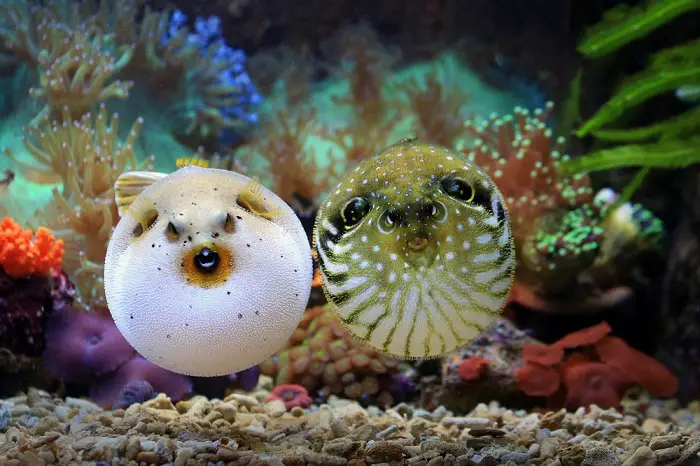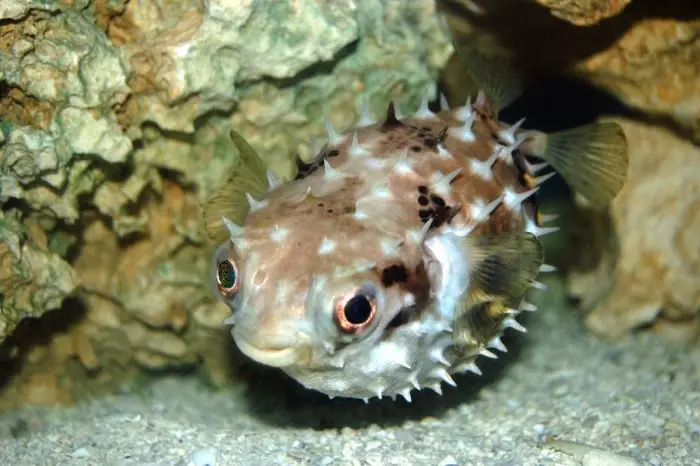Have you ever wondered how puffer fish survive in the depths of the ocean?
Well, prepare to be amazed because, in this blog post, we are going to explore the fascinating world of these inflatable creatures and answer a burning question: do puffer fish breathe?
While it may seem like a simple yes or no answer, the truth is far more intriguing.
Join me on this underwater adventure as we dive into the mysterious respiratory system of puffer fish and uncover the secrets behind their survival.
Gills: The Breathing Apparatus of Fish

Pufferfish possess unique adaptations in their gills that allow them to survive in environments with low oxygen levels.
Unlike other fish, pufferfish have a higher number of gill filaments, which increases the surface area available for oxygen exchange.
This means that they can extract more oxygen from each breath, enabling them to thrive even in oxygen-deprived waters.
Another fascinating feature of pufferfish gills is their ability to adjust and control water flow. Pufferfish can regulate the movement of water over their gills by manipulating the position of their mouth and operculum, a bony flap covering the gill slits.
This mechanism allows them to maximize contact time between water and gill surfaces, optimizing oxygen uptake while minimizing energy expenditure.
Furthermore, pufferfish have an alternative method of respiration called air breathing. When faced with extremely low oxygen levels or stagnant waters, they have the ability to gulp air at the water’s surface and exchange gases through specialized tissues located in their mouth and throat.
This adaptation grants them increased versatility in adapting to various aquatic environments, whether it be a coral reef or a murky swamp.
While most fish rely solely on their gills for respiration, pufferfish employ additional tactics to survive in challenging conditions.
Their unique adaptations not only enable efficient oxygen extraction but also provide them with flexibility when facing unfavorable environmental conditions.
The intricate respiratory system of these captivating creatures reveals nature’s extraordinary ability to adapt and thrive under diverse circumstances.
Puffer Fish: Aquatic Breathing Adaptations
The remarkable adaptability of puffer fish is not limited to their unique ability to inflate themselves as a defense mechanism.
These fascinating creatures also possess gills that are specially adapted for survival in different aquatic environments.
While other fish species may struggle to extract oxygen from oxygen-deficient waters, puffer fish have evolved gills that are adept at doing just that.
This allows them to thrive in a variety of habitats, from oxygen-rich coastal areas to stagnant ponds with low oxygen levels.
What sets the gills of puffer fish apart is their ability to adjust surface area based on the surrounding oxygen levels. This means that when they find themselves in an environment with abundant oxygen, they can increase the surface area of their gills to maximize their intake and extraction.
Conversely, when faced with oxygen-deficient waters, they can reduce this surface area while still efficiently extracting enough oxygen for survival.
This incredible flexibility ensures that puffer fish can regulate their breathing rate and adapt accordingly, guaranteeing their survival even in challenging conditions.
The unique adaptations of the gills allow puffer fish to flourish in diverse aquatic habitats where other species would struggle.
Their ability to extract oxygen even from areas with low levels ensures a constant supply for respiration.
Furthermore, their capacity to modify the surface area of their gills facilitates respirational adjustments based on environmental conditions.
The ingenuity and adaptability displayed by these creatures highlight nature’s awe-inspiring solutions for survival in various ecosystems.
Do Puffer Fish Use Lungs?

The presence of rudimentary lungs or lung-like structures in certain puffer fish is truly remarkable and sets them apart from other fish species. This adaptation not only allows them to survive in oxygen-depleted waters, but also showcases their versatility in adapting to various aquatic conditions. Imagine a puffer fish gracefully rising to the water’s surface and gracefully gulping air, like an amphibian emerging from its watery domain.
One can’t help but marvel at the ingenuity of evolution. It’s astounding how these small creatures have developed such a unique and essential tool for survival. While most other fish rely solely on their gills for respiration, puffer fish have found another way to supplement their oxygen supply when necessary. In the face of stagnant or low-oxygen environments, they possess the ability to take matters into their own hands – or should I say fins – by breathing atmospheric air.
This fascinating adaptation opens up a world of possibilities for these mesmerizing little creatures. From exploring oxygen-poor ponds to navigating through murky mangroves, puffer fish demonstrate that they are more than just adorable round balls floating in the water. They are resilient beings with an impressive array of adaptations; lung-like structures being just one example of their remarkable abilities to thrive in ever-changing aquatic conditions.
Who knew that behind those googly eyes and chubby cheeks lies a creature capable of taking breaths straight from above? The secret lives underwater never cease to amaze us, inviting us further into this mysterious realm where even the most ordinary-looking creatures possess extraordinary abilities. Pufferfish, with their unique lung-like structures, are no exception.
Buoyancy and Breathing in Puffer Fish
The intricate relationship between buoyancy and breathing in fish is a fascinating aspect of their survival strategy. Puffer fish, with their quirky appearance and peculiar behaviors, take this connection to the next level. These remarkable creatures possess an extraordinary ability to control their internal gas content, allowing them to manipulate their buoyancy at will.
Unlike other fish species that depend primarily on swim bladders for buoyancy regulation, puffer fish have a unique system. Instead of relying solely on swim bladders, they also utilize specialized organs called lungs. By inflating or deflating these lungs with air or water, puffer fish can adjust their overall density and floatation in water. This flexible buoyancy management not only impacts their movement but also influences how they breathe.
This ingenious mechanism enables puffer fish to access specific areas in the water column where oxygen levels are high. By controlling their buoyancy, they can stay suspended at the desired depth without expending excessive energy for swimming against currents or struggling to maintain position. This strategic use of buoyancy allows them to optimize their breathing process by efficiently reaching areas abundant in life-giving oxygen.
The interplay between buoyancy and breathing is crucial for the survival of underwater creatures like puffer fish. Their ability to adjust internal gas content grants them unmatched control over their position in the water column and ensures efficient access to oxygen-rich regions. The ingenuity exhibited by these mesmerizing animals serves as a reminder of nature’s remarkable adaptability and diversity.
Survival Strategies: Puffer Fish and Low-Oxygen Environments

In the vast underwater world, survival often relies on the ability to adapt and overcome unforeseen challenges. Puffer fish, with their charismatic appearance and ability to inflate like balloons, exemplify this resilience in the face of adversity. When oxygen levels dip dangerously low, these intriguing creatures do not simply resign themselves to fate. Instead, they exhibit remarkable survival strategies that prove just how adaptable they truly are.
One such strategy involves a change in behavior as puffer fish seek out shallow waters where oxygen concentrations are higher. It’s almost as if these clever underwater dwellers possess an innate knowledge of where to find life-giving oxygen amidst a sea of uncertainty. Not only does this migration showcase their resourcefulness, but it also highlights their ability to think critically and make choices that optimize their chances of survival.
However, perhaps even more fascinating is the fact that some puffer fish species can enter a state similar to hibernation known as aestivation. During extreme conditions characterized by low oxygen levels or scarcity of food sources, these resilient creatures conserve energy by slowing down bodily functions and entering into a deep slumber-like state. Aestivation allows them to endure harsh environments where others would undoubtedly perish – a testament to their incredible adaptability and unwavering determination to survive against all odds.
Puffer fish prove time and again why they are true survivors in challenging environments with their extraordinary adaptability and strategic behaviors. Seeking out areas with higher oxygen concentrations or resorting to aestivation when necessary demonstrates not only intelligence but also a remarkable ability to assess and respond to their surroundings.
Can Puffer Fish Breathe Air?
The ability of certain species of puffer fish to breathe atmospheric air is a testament to their remarkable adaptability. In environments with extremely low oxygen levels, these fish have managed to access an additional source of oxygen, giving them a distinct advantage over their competitors. This unique characteristic highlights the ingenuity of evolution and showcases nature’s ability to find innovative solutions for survival.
Puffer fish are already known for their exceptional defense mechanisms, such as inflating themselves into spiky balloons when threatened. But the development of this ability to breathe atmospheric air takes their adaptive capabilities to another level. By drawing in air through a specialized structure called the labyrinth organ, puffer fish can extract oxygen from the atmosphere and bypass the limitations imposed by low oxygen levels in water.
This adaptation not only enhances their chances of survival but also allows these subaqueous marvels to explore habitats where other fish might struggle or perish altogether. It opens up possibilities for them to occupy new ecological niches and expand their range beyond traditional underwater environments. The fact that some pufferfish can thrive even in severely hypoxic conditions serves as a reminder that nature never ceases to amaze us with its creative solutions for life’s daily struggles.
Do Puffer Fish Breathe? (Summary)
Pufferfish do not breathe in the traditional sense. Instead of using gills to extract oxygen from water, they have a unique method of acquiring oxygen by inflating their bodies and absorbing oxygen through their skin.
This adaptation enables them to survive in low-oxygen environments such as muddy or stagnant waters where other fish would struggle to breathe.
The ability to inflate themselves also serves as a defense mechanism against predators, making them an intriguing and fascinating species.
To learn more about the interesting adaptations and behaviors of puffer fish, we encourage further exploration and research into these remarkable creatures.
Other Blog Posts
- Do Puffer Fish Bite?
- Lionfish vs Stonefish (The Things They Have in Common & What Makes Them Different)
- Lionfish vs Scorpionfish (Common Traits & What Makes Them Different)